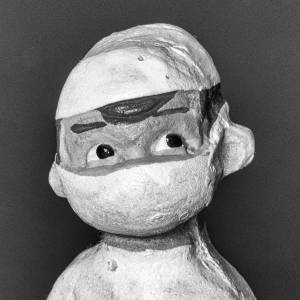Mono-Monday: "Touch" - Braille
JDO (many thanks Jill!) has set the theme "Touch" for this week's Mono-Monday challenge.
As a retired eye doc my thoughts soon turned to the heightened sense of touch which blind and partially-sighted folk develop, especially when the visual handicap dates from childhood: my blip entry of 29th March about a little girl I looked after demonstrates this well.
As most people know, Braille is a system of writing using raised dots, usually embossed on thick paper; although refreshable electro-mechanical Braille displays are now available for computers, text-to-speech software has rather taken over from these in many situations (unless the unfortunate person is deaf as well as blind).
Braille was originally developed in 1824, when he was 15 years old, by a Frenchman called Louis Braille who lost his sight in a childhood accident. He based it on a system of "night writing" designed by Charles Barbier in response to Napoleon's demand for a code that soldiers could use to communicate silently and without light at night.
There are various versions of Braille suitable for different languages and situations. In English Braille there are three levels of encoding: Grade 1 - a letter-by-letter transcription used for basic literacy; Grade 2 - an addition of abbreviations and contractions; and Grade 3 - various non-standardized personal shorthands.
Thinking of Braille takes me back to my childhood, as when my Grandpa retired he took up the "hobby" of transcribing articles into Braille. We're talking about the late 1950s and early 1960s here so it wasn't possible to automate such tasks then. Grandpa died when I was only 11 but I remember some of the details of his Braille writer - it had a metal backboard onto which the paper was clipped, with multiple holes so that pegs on the actual writer could be popped into them to keep it secure for writing a line at a time, then moved to the next holes for the next line. The writer had 3 buttons on each side, operated by the left and right hands at the same time so you had to press the correct buttons to produce one letter at a time (Braille has 6 dots per cell, in two columns of three dots). My Grandpa was remarkably quick at operating it, but it must still have been a labour of love. Sometimes he would let his grandkids loose on it but I rather suspect know for sure that we wrote gobbledegook!
I took today's blip picture at our local station on the Tyne and Wear Metro system (as also featured on my Saturday blip - happily the track replacement work is now finished!). There's a push-button help-point for making enquiries, calling a taxi and for raising an alarm, and I'm impressed that the powers-that-be had the sense to include Braille labels next to each button.
So Hurrah for the sense of touch!

Comments
Sign in or get an account to comment.


